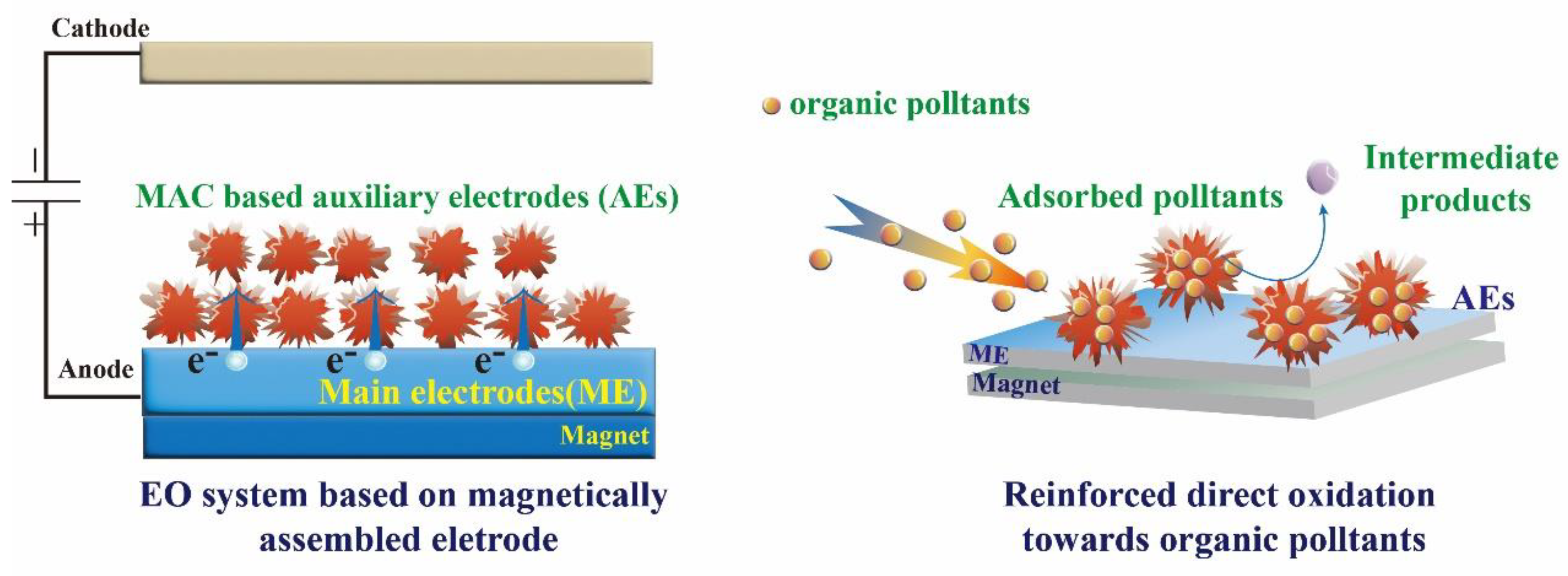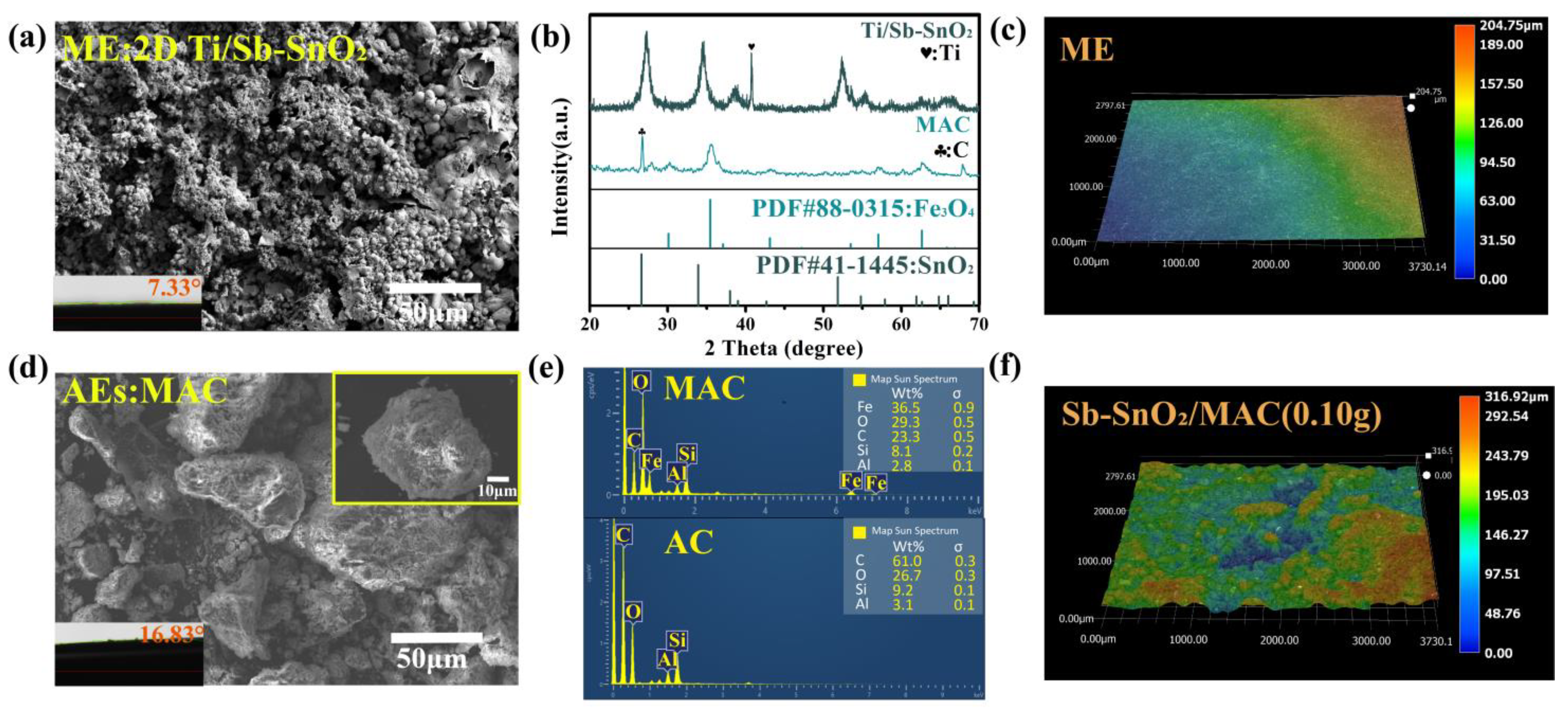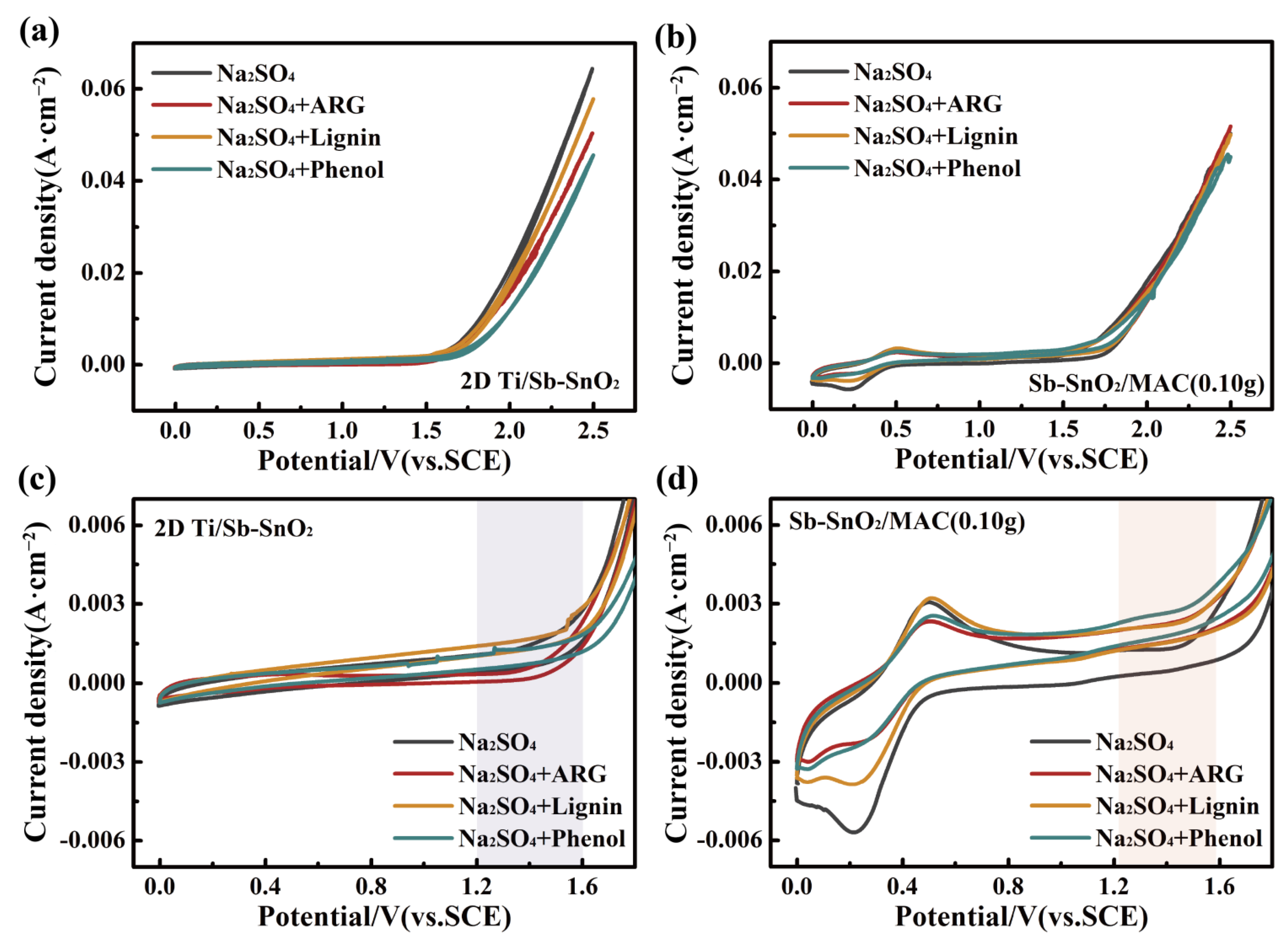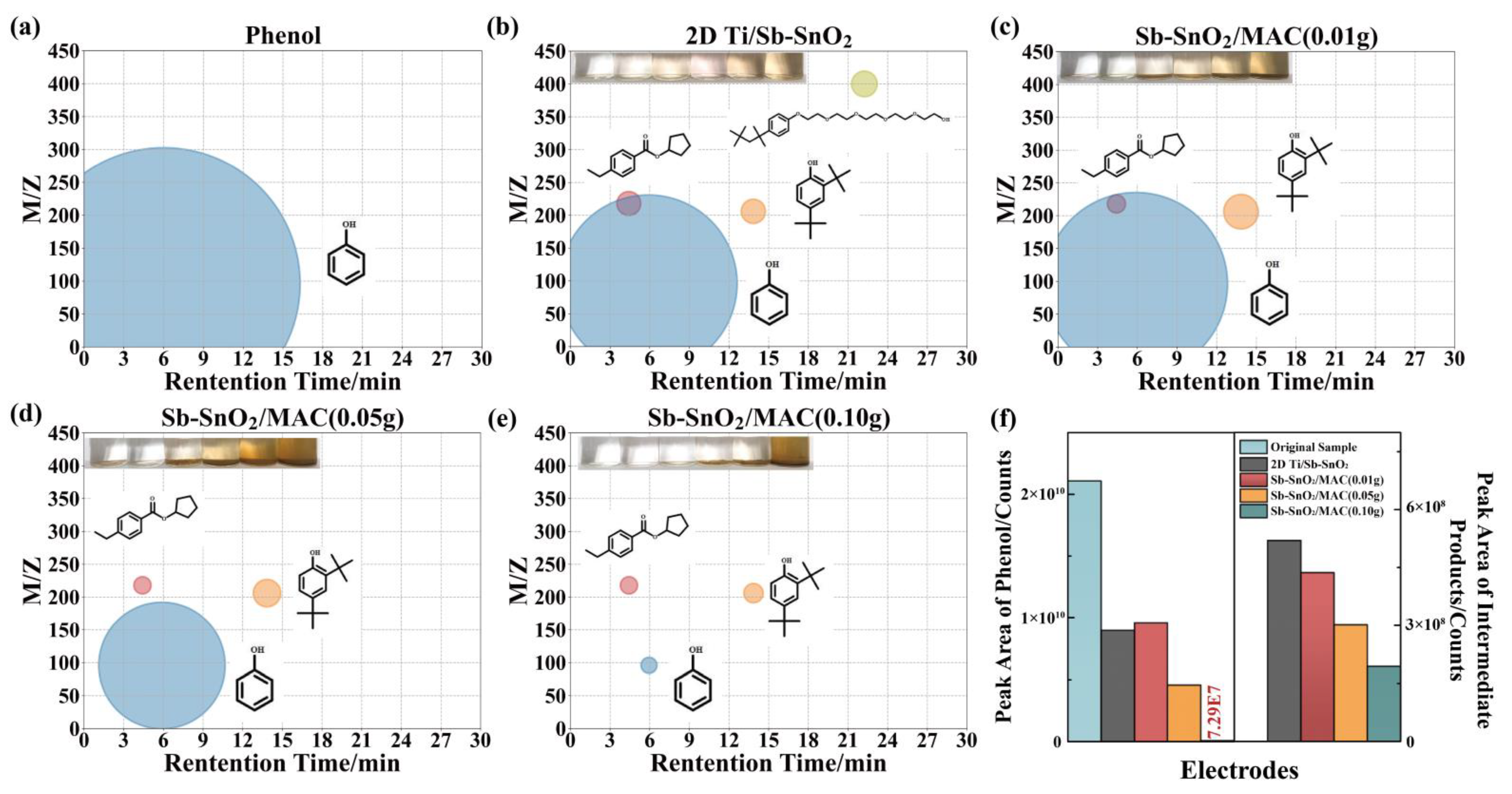New Magnetically Assembled Electrode Consisting of Magnetic Activated Carbon Particles and Ti/Sb-SnO2 for a More Flexible and Cost-Effective Electrochemical Oxidation Wastewater Treatment
Abstract
:1. Introduction
2. Results and Discussion
2.1. Material Characterization
2.2. Electrochemical Characterization
2.3. Pollutant Degradation
2.3.1. Degradation of ARG
2.3.2. Degradation of Phenol
2.3.3. Degradation of Lignin
2.4. Cost-Effectiveness Estimation
3. Experiments
3.1. Preparation of MAE
3.2. Material Characterizations
3.3. Electrochemical Characterizations
3.4. Pollutant Degradation
4. Conclusions
- MAC AEs improve the MAE’s conductivity, increase electrochemical area, increase the number of active sites, facilitate charge transfer and mass transfer, and strengthen the electrode’s direct oxidation (or DET) capability. These characteristics are more significant on the Sb-SnO2/MAC(0.10 g).
- More importantly, the loading amount of MAC AEs has a significant impact on various pollutant degradation rates and intermediate products accumulations. Sb-SnO2/MAC(0.10 g) has the best pollutant degradation ability with the lowest amount of accumulated intermediate products.
Supplementary Materials
Author Contributions
Funding
Data Availability Statement
Acknowledgments
Conflicts of Interest
References
- Martínez-Huitle, C.A.; Rodrigo, M.A.; Sirés, I.; Scialdone, O. Single and Coupled Electrochemical Processes and Reactors for the Abatement of Organic Water Pollutants: A Critical Review. Chem. Rev. 2015, 115, 13362–13407. [Google Scholar] [CrossRef]
- Radjenovic, J.; Duinslaeger, N.; Avval, S.S.; Chaplin, B.P. Facing the Challenge of Poly- and Perfluoroalkyl Substances in Water: Is Electrochemical Oxidation the Answer? Environ. Sci. Technol. 2020, 54, 14815–14829. [Google Scholar] [CrossRef]
- Martínez-Huitle, C.A.; Panizza, M. Electrochemical oxidation of organic pollutants for wastewater treatment. Curr. Opin. Electrochem. 2018, 11, 62–71. [Google Scholar] [CrossRef]
- Zheng, W.; Liu, Y.; Liu, W.; Ji, H.; Li, F.; Shen, C.; Fang, X.; Li, X.; Duan, X. A novel electrocatalytic filtration system with carbon nanotube supported nanoscale zerovalent copper toward ultrafast oxidation of organic pollutants. Water Res. 2021, 194, 116961. [Google Scholar] [CrossRef]
- Panizza, M.; Cerisola, G. Direct and Mediated Anodic Oxidation of Organic Pollutants. Chem. Rev. 2009, 109, 6541–6569. [Google Scholar] [CrossRef]
- Trellu, C.; Coetsier, C.; Rouch, J.-C.; Esmilaire, R.; Rivallin, M.; Cretin, M.; Causserand, C. Mineralization of organic pollutants by anodic oxidation using reactive electrochemical membrane synthesized from carbothermal reduction of TiO2. Water Res. 2018, 131, 310–319. [Google Scholar] [CrossRef] [Green Version]
- Ren, W.; Zhang, Q.; Cheng, C.; Miao, F.; Zhang, H.; Luo, X.; Wang, S.; Duan, X. Electro-Induced Carbon Nanotube Discrete Electrodes for Sustainable Persulfate Activation. Environ. Sci. Technol. 2022, 56, 14019–14029. [Google Scholar] [CrossRef]
- Li, X.; Wu, Y.; Zhu, W.; Xue, F.; Qian, Y.; Wang, C. Enhanced electrochemical oxidation of synthetic dyeing wastewater using SnO2-Sb-doped TiO2-coated granular activated carbon electrodes with high hydroxyl radical yields. Electrochim. Acta 2016, 220, 276–284. [Google Scholar] [CrossRef]
- Shao, D.; Yan, W.; Li, X.; Xu, H. Fe3O4/Sb–SnO2 Granules Loaded on Ti/Sb–SnO2 Electrode Shell by Magnetic Force: Good Recyclability and High Electro-oxidation Performance. ACS Sustain. Chem. Eng. 2015, 3, 1777–1785. [Google Scholar] [CrossRef]
- Shao, D.; Zhang, X.; Lyu, W.; Zhang, Y.; Tan, G.; Xu, H.; Yan, W. Magnetic Assembled Anode Combining PbO2 and Sb-SnO2 Organically as An Effective and Sustainable Electrocatalyst for Wastewater Treatment with Adjustable Attribution and Construction. ACS Appl. Mater. Interfaces 2018, 10, 44385–44395. [Google Scholar] [CrossRef]
- Zhang, X.; Shao, D.; Lyu, W.; Xu, H.; Yang, L.; Zhang, Y.; Wang, Z.; Liu, P.; Yan, W.; Tan, G. Design of magnetically assembled electrode (MAE) with Ti/PbO2 and heterogeneous auxiliary electrodes (AEs): The functionality of AEs for efficient electrochemical oxidation. Chem. Eng. J. 2020, 395, 125145. [Google Scholar] [CrossRef]
- Shao, D.; Zhang, X.; Wang, Z.; Zhang, Y.; Tan, G.; Yan, W. New architecture of a variable anode for full-time efficient electrochemical oxidation of organic wastewater with variable Cl− concentration. Appl. Surf. Sci. 2020, 515, 146003. [Google Scholar] [CrossRef]
- Shao, D.; Zhang, Y.; Lyu, W.; Zhang, X.; Tan, G.; Xu, H.; Yan, W. A modular functionalized anode for efficient electrochemical oxidation of wastewater: Inseparable synergy between OER anode and its magnetic auxiliary electrodes. J. Hazard. Mater. 2020, 390, 122174. [Google Scholar] [CrossRef]
- Zhang, Y.; Zhang, C.; Shao, D.; Xu, H.; Rao, Y.; Tan, G.; Yan, W. Magnetically assembled electrodes based on Pt, RuO2-IrO2-TiO2 and Sb-SnO2 for electrochemical oxidation of wastewater featured by fluctuant Cl- concentration. J. Hazard. Mater. 2022, 421, 126803. [Google Scholar] [CrossRef]
- Shao, D.; Li, W.; Wang, Z.; Yang, C.; Xu, H.; Yan, W.; Yang, L.; Wang, G.; Yang, J.; Feng, L.; et al. Variable activity and selectivity for electrochemical oxidation wastewater treatment using a magnetically assembled electrode based on Ti/PbO2 and carbon nanotubes. Sep. Purif. Technol. 2022, 301, 122008. [Google Scholar] [CrossRef]
- Chaplin, B.P. Critical review of electrochemical advanced oxidation processes for water treatment applications. Environ. Sci. Process. Impacts 2014, 16, 1182–1203. [Google Scholar] [CrossRef]
- Zhan, J.; Li, Z.; Yu, G.; Pan, X.; Wang, J.; Zhu, W.; Han, X.; Wang, Y. Enhanced treatment of pharmaceutical wastewater by combining three-dimensional electrochemical process with ozonation to in situ regenerate granular activated carbon particle electrodes. Sep. Purif. Technol. 2019, 208, 12–18. [Google Scholar] [CrossRef]
- Giannakis, S.; Lin, K.-Y.A.; Ghanbari, F. A review of the recent advances on the treatment of industrial wastewaters by Sulfate Radical-based Advanced Oxidation Processes (SR-AOPs). Chem. Eng. J. 2021, 406, 127083. [Google Scholar] [CrossRef]
- Du, X.; Oturan, M.A.; Zhou, M.; Belkessa, N.; Su, P.; Cai, J.; Trellu, C.; Mousset, E. Nanostructured electrodes for electrocatalytic advanced oxidation processes: From materials preparation to mechanisms understanding and wastewater treatment applications. Appl. Catal. B Environ. 2021, 296, 120332. [Google Scholar] [CrossRef]
- Behling, R.; Valange, S.; Chatel, G. Heterogeneous catalytic oxidation for lignin valorization into valuable chemicals: What results? What limitations? What trends? Green Chem. 2016, 18, 1839–1854. [Google Scholar] [CrossRef]
- Rafiee, M.; Alherech, M.; Karlen, S.D.; Stahl, S.S. Electrochemical Aminoxyl-Mediated Oxidation of Primary Alcohols in Lignin to Carboxylic Acids: Polymer Modification and Depolymerization. J. Am. Chem. Soc. 2019, 141, 15266–15276. [Google Scholar] [CrossRef] [PubMed]
- Shao, D.; Yan, W.; Li, X.L.; Yang, H.H.; Xu, H. A Highly Stable Ti/TiHx/Sb-SnO2 Anode: Preparation, Characterization and Application. Ind. Eng. Chem. Res. 2014, 53, 3898–3907. [Google Scholar] [CrossRef]
- Montilla, F.; Morallón, E.; De Battisti, A.; Vázquez, J.L. Preparation and characterization of antimony-doped tin dioxide electrodes. Part 1. Electrochemical characterization. J. Phys. Chem. B 2004, 108, 5036–5043. [Google Scholar] [CrossRef]







Disclaimer/Publisher’s Note: The statements, opinions and data contained in all publications are solely those of the individual author(s) and contributor(s) and not of MDPI and/or the editor(s). MDPI and/or the editor(s) disclaim responsibility for any injury to people or property resulting from any ideas, methods, instructions or products referred to in the content. |
© 2022 by the authors. Licensee MDPI, Basel, Switzerland. This article is an open access article distributed under the terms and conditions of the Creative Commons Attribution (CC BY) license (https://creativecommons.org/licenses/by/4.0/).
Share and Cite
Zhang, F.; Shao, D.; Yang, C.; Xu, H.; Yang, J.; Feng, L.; Wang, S.; Li, Y.; Jia, X.; Song, H. New Magnetically Assembled Electrode Consisting of Magnetic Activated Carbon Particles and Ti/Sb-SnO2 for a More Flexible and Cost-Effective Electrochemical Oxidation Wastewater Treatment. Catalysts 2023, 13, 7. https://doi.org/10.3390/catal13010007
Zhang F, Shao D, Yang C, Xu H, Yang J, Feng L, Wang S, Li Y, Jia X, Song H. New Magnetically Assembled Electrode Consisting of Magnetic Activated Carbon Particles and Ti/Sb-SnO2 for a More Flexible and Cost-Effective Electrochemical Oxidation Wastewater Treatment. Catalysts. 2023; 13(1):7. https://doi.org/10.3390/catal13010007
Chicago/Turabian StyleZhang, Fanxi, Dan Shao, Changan Yang, Hao Xu, Jin Yang, Lei Feng, Sizhe Wang, Yong Li, Xiaohua Jia, and Haojie Song. 2023. "New Magnetically Assembled Electrode Consisting of Magnetic Activated Carbon Particles and Ti/Sb-SnO2 for a More Flexible and Cost-Effective Electrochemical Oxidation Wastewater Treatment" Catalysts 13, no. 1: 7. https://doi.org/10.3390/catal13010007




